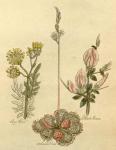 Ragworts contain livertoxic pyrrolizidine alkaloids. Don't use them internally. Read more here. -Henriette
Ragworts contain livertoxic pyrrolizidine alkaloids. Don't use them internally. Read more here. -Henriette
Jacobaea.
A wild plant, very common in our pastures, and distinguished by its ragged leaves, and clusters of yellow flowers. It is two feet high. The stalk is robust, round, striated, and often purplish. The leaves are divided in an odd manner, into several parts, so that they look torn or ragged; their colour is a dark dusky green, and they grow to the stalk without any foot-stalk, and are broad and rounded at the end. The flowers are moderately large and yellow, and the tops of the branches are so covered with them, that they often spread together to the breadth of a plate. The whole plant has a disagreeable smell. The root is fibrous, and the seeds are downy.
The fresh leaves are used: but it is best to take those that rise immediately from the root, for they are larger and more juicy than those on the stalk: they are to be mixed in pultices, and applied outwardly as a remedy against pains in the joints: they have a surprising effect. It is said that, two or three times applied, they will cure the sciatica, or hip gout, when ever so violent.

